Biomaterials and Their Applications
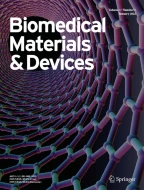
A biomaterial is a biocompatible substance engineered to interact with biological systems for therapeutic and diagnostic, such as pacemakers, dental implants, vascular stents, artificial joints, drug delivery systems, tissue engineering, biosensors, image contrast agents in Computer Tomography, Magnetic Resonance Imaging, optical imaging, and ultrasound. Biomaterials are also used as assays in point-of-care testing devices. Based on the organs’ biological properties, the biomaterials are mainly classified into metals, polymers, ceramics, and composite biomaterials. The success rate of the implant depends on the physical, chemical, and mechanical properties of the selected material. Each biomaterials have unique properties, so it is used in both soft and hard tissue replacements. In this review, various properties and applications of biomaterials are discussed.
This is a preview of subscription content, log in via an institution to check access.
Access this article
We’re sorry, something doesn't seem to be working properly.
Please try refreshing the page. If that doesn't work, please contact support so we can address the problem.
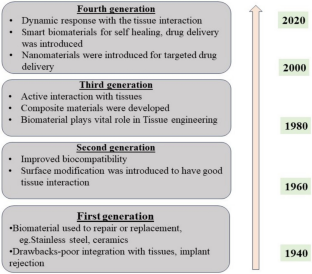
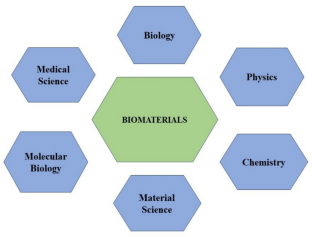
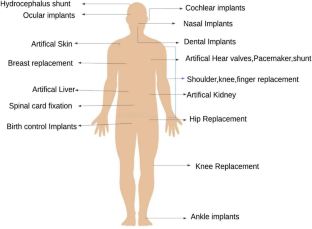
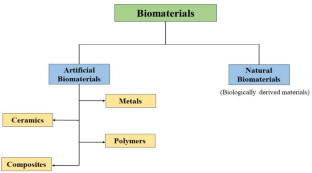
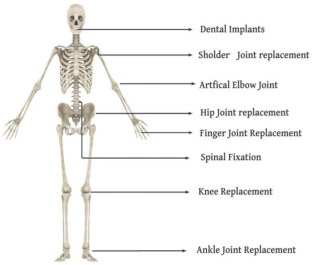
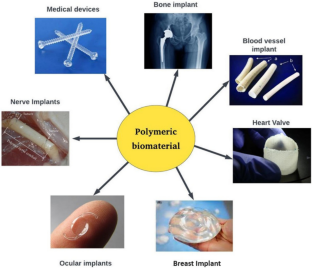
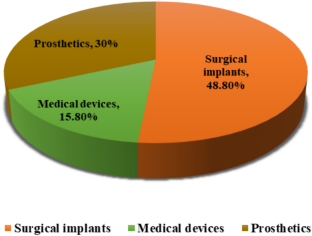
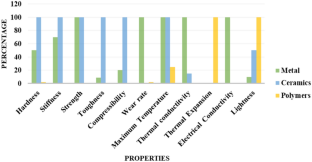
Similar content being viewed by others

Introduction to Biomaterials
Chapter © 2023

Biomaterial types, properties, medical applications, and other factors: a recent review
Article 02 March 2023

Biomaterials: An Introduction to Materials for Biomedical Applications
Chapter © 2021
Explore related subjects
Data Availability
My manuscript has no associated data.
References
- B.D. Ratner, Biomaterials Science: An Evolving Multidisciplinary Endeavor (Elsevier eBooks, Amsterdam, 2013) Google Scholar
- T. Biswal, S.K. BadJena, D. Pradhan, Sustainable biomaterials and their applications: a short review. Mater. Today Proc. 30, 274–282 (2019) ArticleGoogle Scholar
- Brahatheeswaran Dhandayuthapani, Dasappan Sakthi, kumar., Biomaterials for biomedical applications, in Biomedical Applications of Polymeric Materials and Composites. ed. by R. Francis, D. SakthiKumar (Wiley, Hoboken, 2016), pp.1–20 Google Scholar
- F. Habibzadeh, S.M. Sadraei, R. Mansoori, N.P.S. Chauhan, G. Sargazi, Nanomaterials supported by polymers for tissue engineering applications: A review. Heliyon (2022). https://doi.org/10.1016/j.heliyon.2022.e12193ArticlePubMedPubMed CentralGoogle Scholar
- D. Cao, J. Ding, Recent advances in regenerative biomaterials. Regen. Biomater. (2022). https://doi.org/10.1093/rb/rbac098ArticlePubMedPubMed CentralGoogle Scholar
- D. Shekhawat, A Short review on polymer, metal and ceramic based implant materials. Mater. Sci. Eng. (2021). https://doi.org/10.1088/1757-899X/1017/1/012038ArticleGoogle Scholar
- E.T. Chong, Classification and medical applications of biomaterials: a mini review. Bio Integr (2022). https://doi.org/10.15212/bioi-2022-0009ArticleGoogle Scholar
- Vasif Hasirci, Nesrin Hasirci, Metals as Biomaterials (Springer eBooks, NY, 2018), pp.35–49 Google Scholar
- Takayoshi Nakano, Physical and Mechanical Properties of Metallic Biomaterials (Elsevier eBooks, Amsterdam, 2019), pp.97–129 Google Scholar
- T. Matsushita, H. Takahashi, Orthopedic Applications of Metallic Biomaterials (Elsevier eBooks, NY, 2019), pp.431–73 Google Scholar
- Aj. Festas, Medical devices biomaterials: a review. Proc. Inst. Mech. Eng. Part L J. Mater. Des. Appl. 234(1), 218–28 (2019) Google Scholar
- M.C. Tanzi, Biomaterials and Applications (Elsevier eBooks, Amsterdam, 2019), pp.199–287 Google Scholar
- Y. Li, New developments of Ti-based alloys for biomedical applications. Materials 7(3), 1709–1800 (2014) ArticlePubMedPubMed CentralGoogle Scholar
- A.M. Abraham, A. Subramani Venkatesan, review on application of biomaterials for medical and dental implants. Proc. Inst. Mech. Eng. Proc. Part L J. Mater. Des. Appl. 237(2), 249–73 (2022) Google Scholar
- S.K. Juikar, S.G. Warkar, Biopolymers for packaging applications: an overview. Packag. Technol. Sci. 36(4), 229–251 (2022) ArticleGoogle Scholar
- La. Fuente, B.C. Maniglia, C.C. Tadini, biodegradable polymers: a review about biodegradation and its implications and applications. Packag. Technol. Sci. 36(2), 81–95 (2022) ArticleGoogle Scholar
- D. Xia, Emerging polymeric biomaterials and manufacturing techniques in regenerative medicine. Aggregate (2022). https://doi.org/10.1002/agt2.176ArticleGoogle Scholar
- B.S. Heidari, Natural Synthetic and Commercially-available Biopolymers Used to Regenerate Tendons and Ligaments. Bioact. Mater. 19, 179–197 (2023) Google Scholar
- S. Yadav, Biomaterials in medical applications. Curr. Mater. Sci. (2024). https://doi.org/10.2174/2666145416666230420094148ArticleGoogle Scholar
- La. Fuente, C.I. Arias, Biodegradable polymers: a review about biodegradation and its implications and applications. Packag. Technol. Sci. 36(2), 81–95 (2022) ArticleGoogle Scholar
- F.D. Al-Shalawi, Biodegradable synthetic polymer in orthopaedic application: a review. Mater. Today Proc. 74, 540–546 (2023) ArticleCASGoogle Scholar
- S.J. Owonubi, Biomedical Applications of Polyolefins (Elsevier eBooks, Amsterdam, 2017), pp.517–38 Google Scholar
- Kim, Y. K. The use of polyolefins in industrial and medical applications. Polyolefin Fibres, (Elsevier, NY, 2017), pp. 135-155
- N.J. Al-Thani, Polyolefin Composites and Nanocomposites (Springer, Cham, 2015), pp.157–79 Google Scholar
- D.C.G. Púa, Lizeth, biomaterials for orthopedic applications and techniques to improve corrosion resistance and mechanical properties for magnesium alloy: a review. J. Mater. Sci. 58(9), 3879–3908 (2023) ArticleGoogle Scholar
- N. Filip, Biomaterials in orthopedic devices: current issues and future perspectives. Coatings 12(10), 1544 (2022) ArticleCASGoogle Scholar
- B. Love, Polymeric Biomaterials (Elsevier eBooks, Amsterdam, 2017), pp.205–38 Google Scholar
- J.C. Worch, elastomeric polyamide biomaterials with stereochemically tuneable mechanical properties and shape memory. Nat. Commun. (2020). https://doi.org/10.1038/s41467-020-16945-8ArticlePubMedPubMed CentralGoogle Scholar
- M. Winnacker, Polyamides and their functionalization: recent concepts for their applications as biomaterials. Biomater. Sci. 5(7), 1230–1235 (2017) ArticleCASPubMedGoogle Scholar
- M. Shakiba, Nylon: a material introduction and overview for biomedical applications. Polym. Adv. Technol. 32(9), 3368–3383 (2021) ArticleCASGoogle Scholar
- B. Oladapo, 3D-printed Biomimetic Bone Implant Polymeric Composite Scaffolds. Int. J. Adv. Manuf. Technol. 126(9–10), 4259–4267 (2023) ArticleGoogle Scholar
- P. Zarrintaj, Biopolymer-based composites for tissue engineering applications: a basis for future opportunities. Compos. Part B Eng. (2023). https://doi.org/10.1016/j.compositesb.2023.110701ArticleGoogle Scholar
- Tennakoon, Pipuni, Marine-derived Biopolymers as Potential Bioplastics, an Eco-friendly Alternative, iScience, 26(4), (2023).
- H.R. Dana, F. Ebrahimi, Synthesis, properties, and applications of polylactic acid-based polymers. Polym. Eng. and Sci. 63(1), 22–43 (2022) ArticleGoogle Scholar
- R. Gheorghita, applications of biopolymers for drugs and probiotics delivery. Polymers (2021). https://doi.org/10.3390/polym13162729ArticlePubMedPubMed CentralGoogle Scholar
- M. Datta, Application of polymer in biomedical implication. GSC Biol. Pharm. Sci. 14(2), 098–114 (2021) ArticleCASGoogle Scholar
- A.J.T. Teo, polymeric biomaterials for medical implants and devices. ACS Biomater. Sci. Eng. 2(4), 454–72 (2016) ArticleCASPubMedGoogle Scholar
- Sharanabasava V. Ganachari, Polymers for Energy Applications (Springer eBooks, NY, 2019), pp.3011–27 Google Scholar
- A.V. Kaliyathan, Natural Rubber and Silicone Rubber-based Biomaterials (Elsevier eBooks, Amsterdam, 2018), pp.71–84 Google Scholar
- M. Zare, Silicone-based biomaterials for biomedical applications: antimicrobial strategies and 3d printing technologies. J. Appl. Polym. Sci. (2021). https://doi.org/10.1002/app.50969ArticleGoogle Scholar
- P. Li, Biomaterial characteristics and application of silicone rubber and PVA hydrogels mimicked in organ groups for prostate brachytherapy. J. Mech. Behav. Biomed. Mater. 49, 220–234 (2015) ArticleCASPubMedGoogle Scholar
- A. Rahimi, A. Mashak, Review on rubbers in medicine: natural, silicone and polyurethane rubbers. Plast. Rubber Compos. 42(6), 223–230 (2013) ArticleCASGoogle Scholar
- A.V. Singh, V. Vyas, Biofilm formation on nanostructured titanium oxide surfaces and a micro/nanofabrication-based preventive strategy using colloidal lithography. Biofabrication (2012). https://doi.org/10.1088/1758-5082/4/2/025001ArticlePubMedGoogle Scholar
- S. Krishnakumar, T. Senthilvelan, Polymer composites in dentistry and orthopedic applications: a review. Mater. Today Proc. 46, 9707–9713 (2021) ArticleCASGoogle Scholar
- Burhan Ates, Biomedical Applications of Hybrid Polymer Composite Materials (Elsevier eBooks, Amsterdam, 2017), pp.343–408 BookGoogle Scholar
- A. Nandhini, Ceramics and nanoceramics in biomedical applications (Springer eBooks, NY, 2021), pp.763–79 Google Scholar
- Joon Park, Bioceramics (Springer eBooks, NY, 2008) BookGoogle Scholar
- L. Vaiani, Ceramic materials for biomedical applications: an overview on properties and fabrication processes. J. Funct. Biomater. 14(3), 146 (2023) ArticleCASPubMedPubMed CentralGoogle Scholar
- Tadashi Kokubo, Bioceramics and Their Clinical Applications (CRC Press eBooks, Boca Raton, 2008) BookGoogle Scholar
- P. Kazimierczak, Hydroxyapatite or Fluorapatite: which bioceramic is better as a base for the production of bone scaffold?: a comprehensive comparative study. Int. J. Mol. Sci. (2023). https://doi.org/10.3390/ijms24065576ArticlePubMedPubMed CentralGoogle Scholar
- Thais Samira Dias, Souza, Glass-ceramic: controlled crystallization of glasses obtained from biomass ash. Int. J. Ceram. Eng. Sci. 5(6), e10191 (2023) ArticleCASGoogle Scholar
- Mason, Thomas O, bioceramics, Encyclopedia Britannica, (2018)
- Q. Zhou, Additive manufacturing of bioceramic implants for restoration bone engineering: technologies advances, and future perspectives. ACS Biomate. Sci. Eng. 9(3), 1164–1189 (2023) ArticleCASGoogle Scholar
- H. Gul, Bioceramics (Elsevier eBooks, Amsterdam, 2020), pp.53–83 Google Scholar
- D. Veljović, V. Miletic, Bioceramic dental inserts based on calcium phosphate nano-particles. Mater. Horiz. (2023). https://doi.org/10.1007/978-981-19-8718-2_12.ArticleGoogle Scholar
- J. Chevalier, L. Gremillard, Ceramics for medical applications: a picture for the next 20 years. J. Eur. Ceram. Soc. 29(7), 1245–1255 (2009) ArticleCASGoogle Scholar
- I. Roohani, High-resolution Vat-photopolymerization of personalized bioceramic implants: new advances, regulatory hurdles, and key recommendations”. Int. Mater. Rev. 68(8), 1075–1097 (2023) ArticleCASGoogle Scholar
- M. Rezazade, Effect of functionalization on the adsorption performance of carbon nanotube as a drug delivery system for imatinib: molecular simulation study. BMC Chem. (2024). https://doi.org/10.1186/s13065-024-01197-0ArticlePubMedGoogle Scholar
- R. Kumar, Bioceramics: A review on design concepts toward tailor-made (Multi)-functional materials for tissue engineering applications. J. Mater. Sci. 58(8), 3460–3484 (2023) ArticleCASGoogle Scholar
- A.A. Al-allaq, J.S. Kashan, A review in vivo studies of bioceramics as bone substitute materials. Nano Select 4(2), 123–144 (2022) ArticleGoogle Scholar
- C.H. Wu, Development of an innovative carbon-based ceramic material (Springer eBooks, NY, 2002), pp.189–97 Google Scholar
- N.M. Rafiq, A review on multifunctional bioceramic coatings in hip implants for osteointegration enhancement. Appl. Surf. Sci. Adv. (2023). https://doi.org/10.1016/j.apsadv.2022.100353ArticleGoogle Scholar
- G. Sharma, biogenic carbon nanostructured materials for detection of cancer and medical applications: a mini review. Hybrid Adv. (2024). https://doi.org/10.1016/j.hybadv.2024.100166ArticleGoogle Scholar
- L. Vaiani, Ceramic materials for biomedical applications: an overview on properties and fabrication processes. J. Funct. Biomater. (2023). https://doi.org/10.1016/B978-0-12-802792-9.00008-2ArticlePubMedPubMed CentralGoogle Scholar
- N. Tyagi, 3D printing technology in the pharmaceutical and biomedical applications: a critical review. Deleted J. 2(1), 178–190 (2023) Google Scholar
- F. Kern, Design of Ceramic Materials for Orthopedic Devices (Elsevier eBooks, NY, 2017), pp.331–53 Google Scholar
- S.V. Gohil, Polymers and composites for orthopedic applications (Elsevier eBooks, Amsterdam, 2017), pp.349–403 Google Scholar
- D.L. Chung, Composite Materials for Biomedical Applications (Springer, NY, 2003), pp.233–43 Google Scholar
- A. Sachdeva, P.K. Singh, H.W. Rhee, Composite Materials (CRC Press eBooks, Boca Rotan, 2021) BookGoogle Scholar
- C. Jain, Critical review on the developments in polymer composite materials for biomedical implants. J. Biomater. Sci. Polym. Ed. 34(7), 893–917 (2022) ArticlePubMedGoogle Scholar
- V. Raj, B.-B. Composites, Properties, processing, and surface coatings: a review. Trans. Indian Inst. Met. 76(9), 2435–2443 (2023) ArticleCASGoogle Scholar
- A. Verma, S. Ogata, Magnesium based alloys for reinforcing biopolymer composites and coatings: a critical overview on biomedical materials. Adv. Ind. Eng. Polym. Res. 6(4), 341–355 (2023) CASGoogle Scholar
- Y.C. Lu, Biomechanical characteristics of self-expanding sinus stents during crimping and deployment: a comparison between different biomaterials. J. Mech. Behav. Biomed. Mater. (2023). https://doi.org/10.1016/j.jmbbm.2023.105669ArticlePubMedGoogle Scholar
- E.E. Kalaoglu, Comparison of three different biomaterials used in in vitro molar apexification models. BMC Oral Health (2023). https://doi.org/10.1186/s12903-023-03180-yArticlePubMedPubMed CentralGoogle Scholar
- M.F. Alves, R. Pais, Comparison between different fracture toughness techniques in zirconia dental ceramics, journal of biomedical materials research. Part B Appl. Biomater. 111(1), 103–16 (2022) ArticleGoogle Scholar
- Biomaterials: Basic Principles, World Scientific eBooks, (2021), pp. 82–93
- A.V. Singh, Artificial intelligence and machine learning disciplines with the potential to improve the nanotoxicology and nanomedicine fields: a comprehensive review. Arch. Toxicol. 97(4), 963–979 (2023) ArticleCASPubMedPubMed CentralGoogle Scholar
Funding
No funding was received to assist with the preparation of this manuscript.










